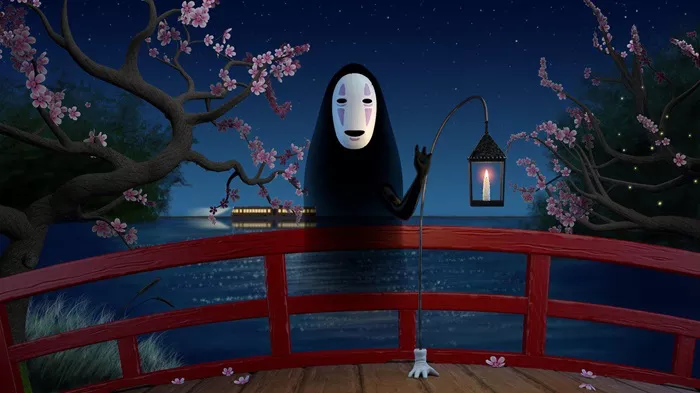Hayao Miyazaki’s animated masterpiece, “Spirited Away,” is a film rich in symbolism and metaphor, exploring themes of identity, transformation, and the human experience. Among its many memorable characters, “No-Face” stands out as one of the most intriguing and enigmatic. With its blank expression and mysterious demeanor, “No-Face” serves as a captivating presence throughout the film, leaving audiences pondering its deeper significance. In this article, we will delve into the symbolism of “No-Face” in “Spirited Away”, exploring its various interpretations and shedding light on its role in the narrative.
The World of “Spirited Away”
“Spirited Away” follows the journey of Chihiro, a young girl who finds herself trapped in a mysterious and magical world after her parents are transformed into pigs. As Chihiro navigates this strange realm and works at a bathhouse for spirits to free herself and her parents, she encounters a diverse cast of characters, each with their own unique traits and motivations. Among these characters is “No-Face,” a spectral figure with a mask-like face and an insatiable appetite.
The Enigmatic Nature of “No-Face”
“No-Face” is introduced in “Spirited Away” as a solitary and seemingly benign spirit who becomes fixated on Chihiro after she shows him kindness by offering him food. Initially quiet and unassuming, “No-Face” gradually becomes more prominent as the story unfolds, ultimately transforming into a chaotic and disruptive force within the bathhouse. Despite its initially gentle demeanor, “No-Face” becomes consumed by greed and desire, mirroring the darker aspects of human nature.
Interpreting the Symbolism of “No-Face”
The character of “No-Face” in “Spirited Away” has been interpreted in various ways, with many viewers and critics offering their own insights into its symbolism and significance. Some of the most common interpretations include:
1. Reflection of Human Emotions
“No-Face” has been seen as a representation of the human capacity for both good and evil. Its initial gentleness and desire for connection with Chihiro reflect the inherent kindness and empathy within all individuals. However, as “No-Face” becomes overwhelmed by negative emotions such as loneliness, envy, and greed, it transforms into a destructive force, illustrating the darker aspects of human nature and the potential for corruption when driven by unchecked desires.
2. Commentary on Consumerism and Materialism
“No-Face’s” insatiable appetite and tendency to consume everything in its path can be interpreted as a critique of consumerism and materialism. As “No-Face” becomes increasingly obsessed with acquiring wealth and possessions, it loses sight of its true self and spirals into a cycle of emptiness and dissatisfaction. This interpretation reflects Miyazaki’s recurring themes of environmentalism and the dangers of prioritizing material wealth over spiritual fulfillment.
3. Exploration of Identity and Self-Discovery
“No-Face’s” journey in “Spirited Away” can also be seen as a metaphor for the process of self-discovery and personal growth. Initially, “No-Face” is a blank slate, lacking a sense of identity or purpose. However, as it interacts with Chihiro and other characters in the bathhouse, it begins to develop its own sense of self and autonomy. Ultimately, “No-Face” learns to reject the negative influences that have consumed it and finds redemption through acts of kindness and selflessness.
4. Symbol of Transformation and Change
“No-Face’s” ability to shape-shift and assimilate the traits of those around it symbolizes the fluid nature of identity and the constant process of transformation and change. Like Chihiro, who undergoes a profound journey of self-discovery and transformation throughout the film, “No-Face” represents the capacity for growth and renewal, even in the face of adversity.
Conclusion
In “Spirited Away,” the character of “No-Face” serves as a captivating and multifaceted symbol, inviting viewers to contemplate its deeper meaning and significance. Whether interpreted as a reflection of human emotions, a commentary on consumerism, an exploration of identity and self-discovery, or a symbol of transformation and change, “No-Face” embodies the complex and often contradictory nature of the human experience. As audiences continue to revisit “Spirited Away” and uncover new layers of meaning within Miyazaki’s masterpiece, the enigmatic presence of “No-Face” remains a source of fascination and intrigue, reminding us of the power of storytelling to inspire reflection and introspection.
FAQs:
1. Why does No-Face become evil?
No-Face becomes evil due to its exposure to negative emotions and desires. Initially, No-Face is a blank slate, but its encounter with greed, loneliness, and envy in the bathhouse corrupts its nature. Consumed by these emotions, No-Face loses control and transforms into a chaotic force, reflecting the darker aspects of human nature.
2. What is the hidden meaning in Spirited Away?
The hidden meaning in Spirited Away lies in its exploration of identity, growth, and the human experience. Through Chihiro’s journey in the spirit world, the film delves into themes of self-discovery, resilience, and the transformative power of empathy and kindness. It serves as a metaphor for the challenges and triumphs of navigating life’s uncertainties and finding one’s place in the world.
3. What was No-Face trying to do?
No-Face’s actions in Spirited Away are driven by its desire for connection and belonging. Initially drawn to Chihiro’s kindness, No-Face seeks to emulate her positive qualities and find acceptance within the bathhouse. However, its inability to control its negative emotions leads to destructive behavior as it attempts to fulfill its desires through material possessions and power. Ultimately, No-Face’s journey reflects the consequences of unchecked desires and the importance of finding inner peace and acceptance.

